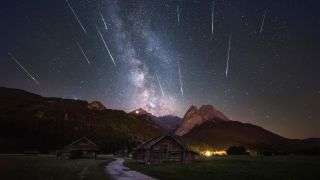
The 2018 Perseid meteor shower seen over Garmisch-Partenkirchen in the Alps.
Skywatchers beware: the moon will hinder attempts to observe the Perseids, typically one of the best meteor displays of the year.
For Northern Hemisphere observers, August is usually regarded as “meteor month,” with one of the best displays of the year reaching its peak mid-month. Unrolling a sleeping bag in the open air is a fine way to enjoy summer meteor showers, particularly the annual Perseid meteor shower, which is beloved by everyone from veteran meteor enthusiasts to summertime campers.
Unfortunately, 2020 will see a last quarter moon on the night of Aug. 11, coinciding with the peak of the Perseids, which is predicted to occur during the overnight hours of Aug. 11-12. From mid-northern latitudes, moonrise comes at around 12:15 local daylight time on Wednesday (Aug. 12). The moon will be hovering about 8 degrees below the Pleiades star cluster and not all that far from the constellation Perseus, from where the meteors will appear to emanate (hence the name “Perseid”).
Most of these “shooting stars” would be identifiable as Perseids because their paths, extended backward along the line of flight, would intersect near a point on the Perseid-Cassiopeia border.
Perseus itself does not begin to climb high up into the northeast sky until after 11 p.m. local time; by dawn it’s nearly overhead. If you plan to make a night out of it, your best observing platform would be a reclining lawn chair allowing you to concentrate overhead and toward the northeast part of the sky.
The moon muscles in
Skywatchers may have already caught a Perseid or two, since the meteor shower started around July 17. But a noticeable upswing in Perseid activity traditionally begins during the second week of August, leading up to their peak.
Perseid meteors are typically fast and bright and occasionally leave persistent trains. Every once in a while, an outstandingly brilliant Perseid fireball will blaze forth, bright enough to be quite spectacular, even perhaps appearing to end in a strobe-like flash. Such an outlier would be more than capable enough to attract attention even in bright moonlight.
Unfortunately, the moon will always be above the horizon during the predawn morning hours, when Perseid viewing is always at its best. That timing means the lunar glare will be very troublesome during the second week of August; the moon will be at a rather bright waning gibbous phase and seriously hamper observation of the buildup of the Perseids. So even the gradual increase in the shower will be spoiled by moonlight.
Under normal conditions, a single observer might see anywhere from 45 to 90 meteors per hour on the night of maximum Perseid activity. This year, the display won’t come close to that number, but the Perseids might still put on an entertaining show despite the interfering moonlight.
Comet crumbs
These meteors are the dross of the Swift-Tuttle comet, which was discovered in 1862 and takes approximately 135 years to circle the sun. In much the same way that the Tempel-Tuttle comet leaves a trail of debris along its orbit that produces the spectacular Leonid meteors of November, the Swift-Tuttle comet produces a similar debris trail, causing the Perseids. Every year during mid-August, when the Earth passes close to the orbit of Swift-Tuttle, the material left behind by the comet from its previous visits rams into our atmosphere at a speed of about 37 miles (60 kilometers) per second, creating fast-moving bright streaks of light in our midsummer night skies.
The Perseids were especially prolific, producing meteors in the hundreds per hour, the last time Swift-Tuttle passed through the inner part of our solar system in 1992. Interestingly, the next two times that the comet will sweep around the sun, in 2126 and 2261, it will pass within about 14 million miles (22.5 million km) of Earth, likely appearing very large and bright in our sky and also producing spectacular Perseid outbursts, again in the hundreds per hour.
In his book, “Impact! The threat of comets and asteroids” (Oxford University Press, 1997), astronomer Gerrit L. Verschuur described the Swift-Tuttle comet as “the single most dangerous object known to humanity.” That point will especially be driven home in the year 3044, when the comet is expected to pass only 1 million miles (1.6 million km) from Earth!
But despite the comet’s superlative, the Perseid “shooting stars” themselves are harmless, no bigger than sand grains or pebbles. With the consistency of cigar ash, the comet’s debris is consumed scores of miles above our heads.
Another August shower to watch
As August progresses, with both the moon and the Perseids on the wane, a different meteor shower will take to the skies, the Kappa Cygnid shower. According to predictions from the International Meteor Organization (IMO), these meteors will peak on Aug. 17, although they began on Aug. 3 and will continue through Aug. 25.
The Kappa Cygnids were juiced up in 2007 and 2014. However, for 2020 there are no available predictions suggesting further peculiarities may occur.
Although this shower produces only a small handful of meteors (two to four) each hour, some of them are flaring fireballs. Best viewing is in the early evening, when the radiant in northwestern Cygnus is nearly overhead. Unlike many other showers, the Kappa Cygnids are associated with no known comet.
Joe Rao serves as an instructor and guest lecturer at New York’s Hayden Planetarium. He writes about astronomy for Natural History magazine, the Farmers’ Almanac and other publications. Follow us on Twitter @Spacedotcom and on Facebook.
Sourse: www.livescience.com





